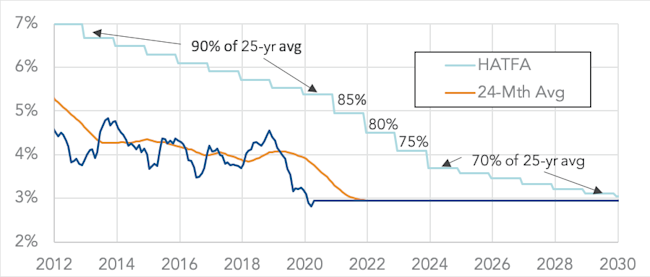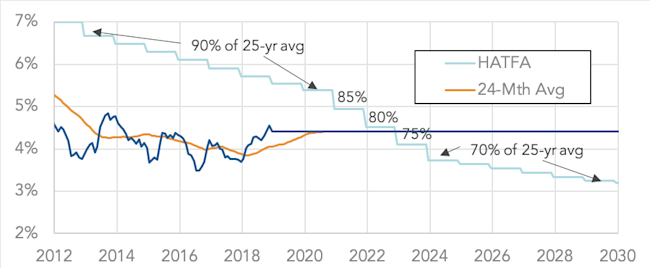Markets 2020 – effect on ERISA minimum funding requirements
We are beginning a series of articles on the effect of the current crisis on retirement plan finance.
As we discussed in our introduction to these issues, the current situation is (to state the obvious) very volatile. For most plans (on a calendar year), 2020 funding requirements will depend on year-end interest rate and asset data, and much could change between now and then.
Our goal with this series is to provide plan sponsors with a clear picture of all the moving parts involved in plan finance calculation, and the significance of both current interest rate declines and asset losses for minimum funding, PBGC premiums, lump sum de-risking, etc.
In this article we discuss effects on ERISA minimum funding requirements. To be clear, we are only talking about minimum funding requirements (in effect, the DB plan’s cash demands), which are subject to a number of complicated (and not particularly transparent) rules. We are not talking about GAAP or “real life.”
Bottom line
To begin with a (very brief) bottom line: Funding requirements for 2020 for a calendar year plan were locked in as of January 1, 2020. 2020 asset declines may affect minimum funding as early as 2021. Interest rate declines won’t show up in minimum funding numbers until 2023. If they persist.
We discuss the details of this below, starting with a review of what is happening with interest rates.
Current and projected interest rates
The following chart compares historical and projected HATFA, 24-month average, and spot rates for a typical (duration 12) pension plan, reflecting changes in market interest rates through March 13, 2020.

Chart 1: PPA Effective Interest Rates, 2012-3/13/2020
Here is the same chart as of the beginning of 2019:

Chart 2: PPA Effective Interest Rates, 2012-1/1/2019
As these charts show, a little more than a year ago market (spot) interest rates were projected to be higher than HATFA rates beginning around 2023. HATFA rates now look like they will be the plan funding valuation interest rates for the long run – much longer than next 10 years.
That is bad news for sponsors concerned about defined benefit plan cash demands. What has changed? At the beginning of 2019 it looked like market interest rates would be higher than HATFA rates beginning in 2023 – now it’s just (lower) HATFA rates and higher valuations all the way down.
Datapoint #1: Liability valuations will go up beginning in 2023.
* * *
Sidebar: HATFA, 24-month average and spot interest rates — nomenclature
HATFA rates are minimum funding interest rates determined under the Highway and Transportation Funding Act (HATFA), as amended by the Bipartisan Budget Act of 2015 (BBA). For 2019 and 2020, HATFA rates are based on 90% of the average of rates for a (trailing) 25-year period. They may generally be used for determining minimum funding, but not for determining variable-rate premiums.
HATFA rates are (as the chart indicates) significantly higher than 24-month average and spot rates in the near term. The “90%” multiplier phases down over the period 2021-2024 to 70%, accounting for much of the reduction in HATFA rates shown in the chart. The point at which the HATFA rates “cross” 24-month average and spot rates is where the HATFA 25-year average interest rate stabilization is projected to no longer apply.
That crossing point doesn’t even show up on our current chart, which only looks 10 years into the future.
24-month average rates are minimum funding interest rates determined under the Pension Protection Act (PPA). They are the average of rates for a (trailing) 24-month period. They are used for determining minimum funding and may (subject to certain limitations) be elected as an “alternative” method for determining PBGC variable-rate premiums.
Spot rates are 1-month average rates and can be thought of (more or less) as market rates. They may (alternatively) be used for plan funding and are the default method for determining variable-rate premiums.
In each case, the index for calculating these rates is high quality corporate bonds.
* * *
Asset performance and funding
If a plan sustains significant 2020 asset losses, it may see an increase in ERISA minimum funding requirements before 2023 (that is, before declining interest rates begin to affect funding), but the situation is somewhat complicated.
Contributions for 2020 are based on asset values determined as of January 1, 2020, so 2020 asset losses will have no effect on 2020 funding. They may, however, increase a plan’s funding shortfall and minimum funding requirements for 2021. That shortfall will generally have to be paid for beginning in 2022, starting with 2022 quarterlies and ending with the September 2022 residual contribution for 2021.
Datapoint #2: Asset declines may require additional contributions beginning as early as 2022 (April 15, 2022 for calendar year plans).
* * *
Sidebar: Assets and the minimum funding equation
Minimum funding requirements are a function of the plan’s funding shortfall – more or less the plan’s liabilities (determined using the liability valuation interest rate discussed above) minus the value of plan assets. The value of plan assets may be smoothed over a period of not more than 24 months. And different plans will have different asset strategies and different 2020 results.
These effects will, however, to some extent be mitigated by PPA’s seven-year amortization provision, which will spread the cost of the shortfall over seven years and may be offset by gains in other (e.g., subsequent) years.
All of these factors will complicate the effect of asset declines on minimum funding requirements.
* * *
Funding Regime 2
More problematic for some plans will be what we have called PPA’s “Funding Regime 2” – a number of requirements and restrictions (e.g., on the payment of lump sums) that are triggered when plan funding falls below 80%.
If the sponsor wants to avoid Regime 2 restrictions for 2021 (e.g., to implement a 2021 lump sum de-risking program), it may have to make significant contributions in 2021.
Datapoint #3: Sponsors that want (or need) to keep plan funding above the 80% Regime 2 trigger may have to make contributions by March 31, 2021.
* * *
At month-end we will update this article with an analysis of the change in funded position and possible increased 2021 funding for a typical plan.
For many sponsors, funding decisions will not be driven by ERISA minimum funding rules but by the high cost of PBGC variable-rate premiums. In our next article we will discuss the effects of the current crisis on the variable-rate premium equation.
For our most current updates on ERISA minimum funding requirements, please see our most recent article on the subject from March 24, 2020.
